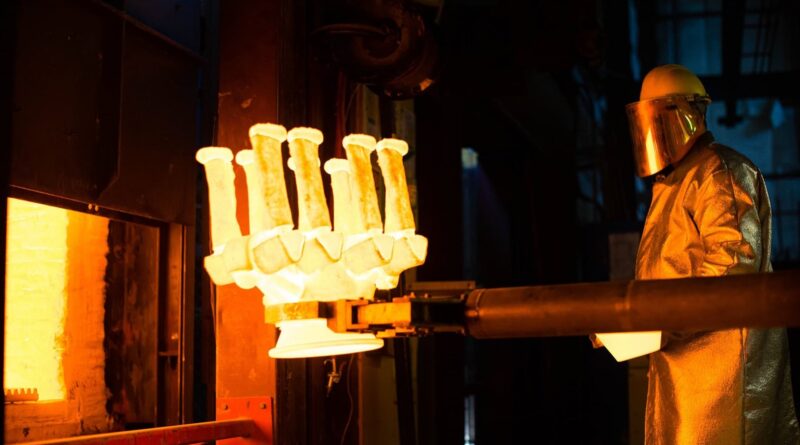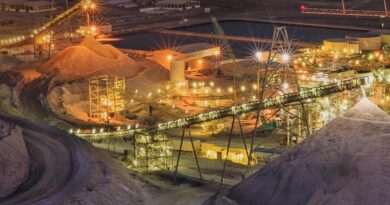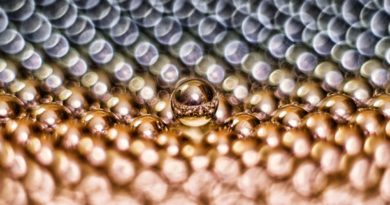Zircon unique properties essential for high-performance jet engine turbine blades
Dr Keven Harlow, executive director, Zircon Industry Association explains why the unique properties of Zircon are essential for the manufacture of high-performance jet engine turbine blades.
The aerospace industry strives to ensure that its aircraft run as efficiently as possible, reducing fuel consumption and lessening the environmental footprint. Millions of dollars are invested in engineering advanced materials, designing more efficient engines and developing manufacturing processes to cut waste and reduce the impact on the environment. One of the critical ways to maximise efficiency is to manufacture parts using materials that are both lightweight and can operate in the harshest of conditions.
There is one material that is vital in the manufacture of precision parts like turbine blades: zircon, a natural mineral that is found in ancient heavy mineral sand deposits around the world, principally in Australia and Africa.
Zircon has a unique range of properties that make it ideal for advanced ceramics that ensure jet engines run cleanly and efficiently. It also plays a vital supporting role in the manufacture of the many intricate parts that are vital to keeping aircraft airborne.
Zircon in investment casting
Zirconium silicate (ZrSiO4), known more widely as zircon, plays a unique and critical role in the manufacturing of precision aerospace parts to ensure they can withstand the harshest of environments. A turbine blade, for example, whilst only weighing 300 grams and measuring around 10cm, is critical to an engine’s performance – rotating at 12,000rpm with a blade speed of around 800mph.
The manufacturing process used to achieve such levels of structural integrity is known as investment casting (or lost wax process) – one of the oldest metal casting techniques.
Investment casting allows intricate parts to be produced with extremely high dimensional accuracy, repeatability, versatility and integrity in a variety of metals and high-performance alloys. Compared to other manufacturing methods, investment casting offers a cost-effective way of producing parts with excellent surface finish, therefore lessening the need for secondary machining processes.
The complex investment casting process can take several days to complete and consists of a number of steps. It begins by creating a master pattern of the required part (casting) often made from clay, metal or other materials. A replica model of the casting is then made using wax. In the case of turbine blades and other such parts it is imperative that the models are free of any defects.
This is the reason why leading aero-engine manufacturers use X-ray technology as well as the human eye to inspect each wax model to identify any imperfections such as cracks or chips at this early stage of the process. Once the models pass inspection, they are assembled onto a wax feeder system, which allows a mould slurry to flow freely across each model.
Depending on the size of the part being cast there can be several wax models on a feeder system or ‘tree’. The whole tree is then dipped and rotated, by robot, into a high-grade zircon-based ceramic slurry to create the mould.
From wax model to ceramic mould
The first coating of the zircon ceramic slurry is critically important because this is the surface that the molten metal will contact when it is poured into the mould, once the wax is removed. The materials used and physical properties of the primary slurry are crucial to the surface quality of the finished castings, particularly for high reactivity titanium alloys.
During the primary coats, zircon-based slurries are used, because zircon does not react with the molten metal. Zircon’s consistent and fine grains, along with its refractoriness, allows the creation of high-precision castings and reduces or eliminates a variety of casting defects and surface imperfections that can occur during casting production. Zircon’s round shape and high density increases the slurry’s ability to flow around the model and drain away, whilst its high thermal conductivity increases thermal shock resistance.
Once the primary coating of ceramic slurry is achieved, stuccoing takes place where the model is coated with a fine zircon sand to build a thicker mould coat. This takes place by dipping patterns into a fluidised bed, placing them in a rainfall-sander, or by applying materials by hand.
Using zircon sand for the coating process is effective, again because of its consistent grain fineness, its high melting point (2,190°C), low thermal expansion (a third that of silica), good resistance to abrasion, and high density. It is also non-wetting when in contact with molten metal.
Once the ceramic moulds are completely dry, they are turned upside-down and placed in a furnace or autoclave to melt or vaporise the wax. To minimise mould stress the wax is heated as quickly as possible so that the outer wax surface melts and drains quickly, allowing the rest of the wax to expand.
Wax recovered from the process is usually recycled. Once the wax melts, it leaves a mould cavity in the shape of the part being cast. The mould is then fired at over 1,700°C to strengthen it and remove any remaining wax.
This enables the mould to withstand the thermal stresses associated with the next stage of the investment casting process. Molten metal is poured into the mould, enabling the metal to completely fill the cavity and take on the mould’s intricate shape.
After cooling, the carefully created ceramic mould is separated from the metal cast by varying methods including vibrating hammers, sand blasting or chemical cleaning. Finishing processes follow but are generally minimal because of the precision of the investment casting process.
The exact investment casting process used by aero-engine manufacturers is a well-guarded secret. But it is clear that investment casting is used in the manufacturing because the process requires flawless precision. Not surprising when you consider turbine blades operate in the hottest part of the engine at temperatures up to 200°C above the melting point of their alloy and sit in a disc that rotates at more than 12,000rpm, creating a centrifugal force equivalent to the weight of a London bus hanging off each blade.
Zircon in thermal barrier coatings
The specialist investment casting process ensures turbine blades are formed as a single metal crystal to maximise their mechanical properties. They are then coated with a heat-resistant ceramic. Such thermal barrier coatings are usually applied to metallic surfaces which are needed to withstand significant temperatures as a form of exhaust heat management.
Zirconia ceramics provide an ultra-thin, diamond-like coating for jet engine blades, protecting the metal alloy of the blades and allowing them to withstand significantly higher temperatures. The coating also limits the thermal exposure of an engine’s structural components, extending the life of the parts by reducing oxidation and thermal fatigue.
Turbine efficiency is strongly correlated with combustion temperature, so these coatings allow the engines to run at a hotter temperature, thereby increasing their fuel efficiency and lessening their environmental impact.
Thermal barrier coatings typically consist of four layers: the metal substrate, metallic bond coat, thermally-grown oxide, and a ceramic topcoat. The most commonly used ceramic topcoat is made from yttria-stabilised zirconia (YSZ), which is also derived from zircon, that has the benefit of having very low conductivity while remaining stable at extremely high temperatures. This ceramic layer insulates the lower levels from the elevated temperatures of the in-flight operating conditions.
Turbine blades may be small but their job is unbelievably demanding. One high-pressure turbine blade extracts around 1,000hp from the gas flow towards the rear of the engine, which is equivalent to the power of a Formula 1 racing car.
Their ability to operate in the harshest of conditions and meet exceptional operational demands over long periods of time is made possible through the complex investment casting process and thermal barrier coatings in which zircon and its derivative products play a vital role.




